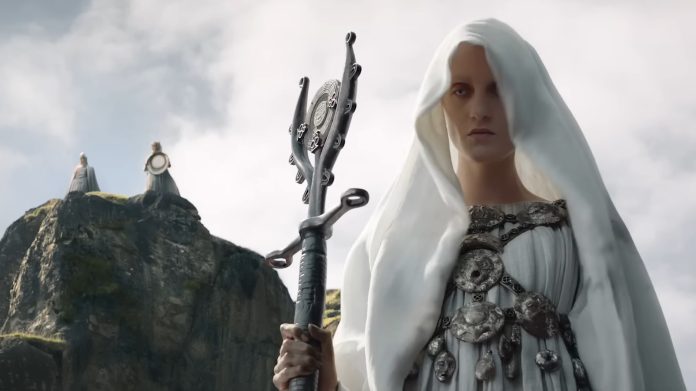The Mystical Women of The Rings of Power: Are They Witches or Sorcerers?
When you dive into The Rings of Power, one of the most intriguing elements that quickly catches your attention is the enigmatic trio of white-clad women. But who exactly are these mystical figures? They appear almost ethereally, pursuing The Stranger (played by Daniel Weyman) throughout Season 1. Initially, their aim is to enlist him for their master’s nefarious agenda, convinced he is none other than Sauron. However, as the plot thickens, and they discover that he is a different Istar, the nature of their intentions takes a darker turn.
As the story unfolds in Season 2, these enchanting yet fearsome women return, now flanked by a Dark Wizard. This begs the pressing question: Are these women just witches, or do they embody something deeper? While the term "witch" floats around, Tolkien’s works suggest there’s more nuance to their identity. Let’s unravel the mysterious tapestry of magic-wielders in Middle-earth.
Understanding Wizards and Magic-Wielders in Tolkien’s World
When delving into the lore of J.R.R. Tolkien, it’s essential to explore the distinction he makes between Wizards and ordinary magic-wielders. In his Unfinished Tales, Tolkien provides clarity on this nuanced world. The Elvish term istar translates more accurately to "wizard" or "wise one," but it’s important to note that these Wizards are fundamentally different from what popular culture would describe as wizards or witches.
This distinction is vital when pondering the nature of the women in The Rings of Power. Wizards in Tolkien’s narrative are a rare breed—specifically, one of five recognized Istari. They are Maiar, or spirits of an angelic kind, who possess unique powers capable of self-incarnation into human or Elvish forms. So, while the three witches are indeed powerful in their own right, they do not belong to the same elevated class as the Istari. They might not be Wizards as Tolkien outlines, but they certainly wield power that could rival many others.
The Role of Non-Wizard Magic-Wielders in Middle-earth
Despite Tolkien’s framework placing Wizards on a different plane, he does depict ordinary mortals engaging in various magical and cult-like activities. An excellent example arises with the Mouth of Sauron, a character who exhibits immense sorcery and an unsettling knowledge of Sauron’s mind. Additionally, The Silmarillion narrates the haunting legacy of the Ringwraiths—once kings and sorcerers, now bound to darkness.
Tolkien even alludes to magical practices among Dwarves, who guarded their treasures with powerful spells. To deepen our understanding of magic in Middle-earth, we must also look at the narrative of the two Blue Wizards. Their roles evolved over time, leaving room for speculation. Initially perceived as having abandoned the path of wisdom, Tolkien later suggested they might have been heroes in distant lands, akin to Gandalf.
But their legacy is intriguing. Tolkien hinted that these powerful Istari might have become founders of secret cults and magical traditions that had long-standing implications, even after Sauron’s fall. This backdrop sets the stage for the mystical women we encounter in The Rings of Power.
Defining the Enigmatic Trio: Witches or Sorceress Acolytes?
As Season 2 of The Rings of Power unfolds, we are presented with magical rituals, including enchanting powers and sacrifice that echo deeply within Tolkien’s lore. The white-clad women clearly possess arcane knowledge, invoking spells and performing displays of power that blur the lines between wizards, sorcerers, and what we might label as witches.
Take into account the scene where the trio engages in a ritual sacrifice to resurrect a fallen comrade—a testament to their deep-rooted magical capabilities. Considering Sauron’s mastery over the Nine Nazgûl, extending mortal life for thousands of years, it becomes evident that the realm of magic in Tolkien’s universe is complex and nuanced.
We may not find the explicit label of "witch" in Tolkien’s tomes, yet, based on their actions and abilities established in both Seasons 1 and 2, it’s clear that the women of The Rings of Power act as powerful magic-wielders, whether we call them sorcerous acolytes or witches.
Conclusion: The Evolving Nature of Magic in Middle-earth
In summarizing the fascinating exploration of magic-wielding entities in The Rings of Power, we can firmly state that the presence of these white-clad women adds a rich layer of intrigue.
Are they witches? The terminology may vary, but their essence resonates with power, magic, and ambition reminiscent of Tolkien’s expansive universe. Season 2 promises to unfold even more revelations about their role and intentions, leaving fans eagerly speculating on the nature of these mystical figures in the lore of Middle-earth. The line between “witch” and “sorceress” might be paper-thin, but one thing is certain—they are undeniably a force to be reckoned with, evoking both awe and fear in their quest for ultimate power.

